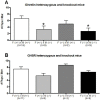Ghrelin modulates testicular damage in a cryptorchid mouse model
- PMID: 28542403
- PMCID: PMC5436858
- DOI: 10.1371/journal.pone.0177995
Ghrelin modulates testicular damage in a cryptorchid mouse model
Abstract
Cryptorchidism or undescended testis (UDT) is a common congenital abnormality associated with increased risk for developing male infertility and testicular cancer. This study elucidated the effects of endogenous ghrelin or growth hormone secretagogue receptor (GHSR) deletion on mouse reproductive performance and evaluated the ability of ghrelin to prevent testicular damage in a surgical cryptorchid mouse model. Reciprocal matings with heterozygous/homozygous ghrelin and GHSR knockout mice were performed. Litter size and germ cell apoptosis were recorded and testicular histological evaluations were performed. Wild type and GHSR knockout adult mice were subjected to creation of unilateral surgical cryptorchidism that is a model of heat-induced germ cell death. All mice were randomly separated into two groups: treatment with ghrelin or with saline. To assess testicular damage, the following endpoints were evaluated: testis weight, seminiferous tubule diameter, percentage of seminiferous tubules with spermatids and with multinucleated giant cells. Our findings indicated that endogenous ghrelin deletion altered male fertility. Moreover, ghrelin treatment ameliorated the testicular weight changes caused by surgically induced cryptorchidism. Testicular histopathology revealed a significant preservation of spermatogenesis and seminiferous tubule diameter in the ghrelin-treated cryptorchid testes of GHSR KO mice, suggesting that this protective effect of ghrelin was mediated by an unknown mechanism. In conclusion, ghrelin therapy could be useful to suppress testicular damage induced by hyperthermia, and future investigations will focus on the underlying mechanisms by which ghrelin mitigates testicular damage.
Conflict of interest statement
Figures







References
-
- Kumar V, Misro MM, Datta K. Simultaneous accumulation of hyaluronan binding protein 1 (HABP1/p32/gC1qR) and apoptotic induction of germ cells in cryptorchid testis. J Androl 2012; 33: 114–21. doi: 10.2164/jandrol.110.011320 - DOI - PubMed
-
- Liu F, Huang H, Xu ZL, Qian XJ, Qiu WY. Germ cell removal after induction of cryptorchidism in adult rats. Tissue Cell 2012; 44: 281–7. doi: 10.1016/j.tice.2012.04.005 - DOI - PubMed
-
- Shikone T, Billig H, Hsueh AJ. Experimentally induced cryptorchidism increases apoptosis in rat testis. Biol Reprod 1994; 51: 865–72. - PubMed
-
- Hikim AP, Lue Y, Yamamoto CM, Vera Y, Rodriguez S, Yen PH, et al. Key apoptotic pathways for heat-induced programmed germ cell death in the testis. Endocrinology 2003; 144: 3167–75. doi: 10.1210/en.2003-0175 - DOI - PubMed
-
- Barqawi A, Trummer H, Meacham R. Effect of prolonged cryptorchidism on germ cell apoptosis and testicular sperm count. Asian J Androl 2004; 6: 47–51. - PubMed
MeSH terms
Substances
LinkOut - more resources
Full Text Sources
Other Literature Sources
Molecular Biology Databases
Research Materials

